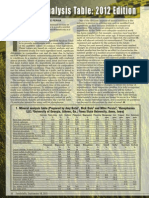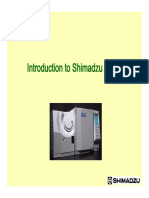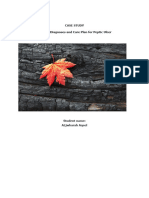Feed Sampling and Analysis
Uploaded by
LAGFeed Sampling and Analysis
Uploaded by
LAGSWINE NUTRITION GUIDE
GENERAL NUTRITION PRINCIPLES
Feed Sampling and Analysis
Quality of ingredients and complete feeds is essential Bags
for effective swine nutrition practices. Analyses to
monitor the quality of ingredients and feeds on a regular The sampling equipment for bagged feeds or
basis help to avoid errors in estimating nutrient content ingredients is the bag trier (Figure 4). The bag trier
of ingredients and to identify inaccuracies in feed should be inserted diagonally in one corner to reach the
formulation or feed manufacturing. Moreover, chemical opposite corner of the bag (Figure 5). At least 10 bags
analyses of feed ingredients are important to assign should be collected from the lot, with random selection
nutritional values to feed ingredients. In order to obtain of bags at varying locations in the lot. The sample size
accurate nutrient values for ingredients and feeds, it is should be at least 1 lb and preferentially 2 lb per bag
essential to conduct appropriate sampling and analysis. (AAFCO, 2017).
Sampling procedure Liquids
The sampling procedure of liquid ingredients, such as
For adequate sampling procedure, it is essential to use
fats, oils, and amino acids, can be performed from bulk,
proper sampling equipment to ensure the collection of a
tanks or barrels, or during unloading. The sampling
representative sample (Gonçalves et al., 2016).
equipment for liquid ingredients in bulk is the bomb
sampler and in tanks or barrels is the drum thief sampler.
In both cases, liquid ingredients should be stirred before
Bulk sampling to ensure a proper distribution of nutrients. At
The most common sampling equipment for bulk feeds least 500 ml or 1 pint of liquid ingredients should be
or feed ingredients is the slotted grain probe (Figure 1), collected from the container (AAFCO, 2017).
which can be manual or automated. The slotted grain
probe should be long enough to reach the bottom of the
bulk carrier to obtain a representative sample from top Feeders
to bottom. Samples should be collected from at least 10
Samples of complete feed are collected from feeders
evenly-spaced locations in the bulk carrier (Figure 2) to
by probe or hand-grab sampling. Samples collected with
be representative of the entire load of feed or feed
a probe have less variability and require fewer number of
ingredient (AAFCO, 2017).
samples (Jones et al., 2018). Samples should be collected
Alternatively, a pelican sampler (Figure 3) is also from at least 6 feeders with probe and 9 feeders by hand.
commonly used to steam cut samples during loading or Approximately 1 to 2 lb of feed should be collected per
unloading of bulk feeds or feed ingredients. Samples feeder and mixed in a composite sample. Creating a
should be collected at least 10 times at regular intervals composite sample by mixing feed from the sampled
during loading or unloading (AAFCO, 2017). feeders is recommended to minimize variability and
reduce the number of samples for analysis (Jones et al.,
In either sampling procedure, the sample size should
2018).
be at least 1 lb and preferentially 2 lb (AAFCO, 2017).
Figure 1. Slotted grain probe Figure 2. Sampling locations in Figure 3. Pelican probe
(Herrman, 2001) bulk carriers (AAFCO, 2017) (Herrman, 2001)
Kansas State University Applied Swine Nutrition 1
Figure 4. Bag trier (Herrman, 2001) Figure 5. Bag sampling technique (AFFCO, 2017)
Figure 6. Riffle divider (Herrman, 2001) Figure 7. Quartering method (Herrman, 2001)
Preparation of samples for analysis Analysis
Sample preparation involves reduction of samples to a The decision on which analyses to perform depends
suitable size for analysis (Gonçalves et al., 2016). First, on the individual ingredient and the intended use of the
composite samples of feeds or ingredients should be results for either purchasing or diet formulation. In
mixed thoroughly. Then, samples are split with a riffle general, analysis of ingredients and feeds often
divider (Figure 6) or by the quartering method (Figure comprises: dry matter (DM), crude protein (CP), ether
7). The process should yield two samples of extract (EE), neutral detergent fiber (NDF), lysine,
approximately 500 g or 1 lb each: one to be submitted calcium, and phosphorus. For analysis of highly variable
for analysis and a second one to be retained as a backup nutrients like calcium, it is recommended to submit
(Herrman, 2001). multiple samples for analysis and to analyze samples in
duplicates (Jones et al., 2018).
Samples for analysis should be placed in plastic or
paper bags for submission. Plastic bags are Specific analysis for fat and oil quality or mycotoxin
conventionally used, but paper bags are preferred for concentration should also be considered in some
high-moisture or mold-contaminated samples to situations.
prevent condensation of moisture and proliferation of
A list of commercial laboratories performing analyses
mold growth. Samples should be identified with sample
of complete feeds and feed ingredients and is shown in
number, date, and content (Herrman, 2001). Labels
List 1.
should not be placed within the bag in contact with the
sample (AAFCO, 2017).
Retained samples should be placed in plastic bags, Interpretation of analysis results
labeled, and immediately frozen for storage. Retained
samples should be kept for a predetermined period of The analysis results should be interpreted on as-fed,
time. Usually, the minimum is until feed is consumed by as-is, or as-received basis, but not on dry-matter basis.
the animals or as long as potential liability exists, e.g. These values can then be compared with the expected
until marketing (Herrman, 2001). nutrient specifications of ingredients or with the
intended nutrient levels in diet formulation (Reese and
Thaler, 2010). The analyzed values generally do not
match the expected values perfectly because of normal
Kansas State University Applied Swine Nutrition 2
variations associated with sampling and laboratory In cases where the analyzed values do not fall within
analyses. The errors associated with sampling can be the expected range after considering the analytical
minimized by following the procedures for sample variation, it is recommended to submit the retained
collection described above. The analytical variation is sample for a repeat analysis. If the analyzed values are
usually taken into consideration to determine consistent between the first and second analysis, there
acceptability of feeds and ingredients, which is generally could be an indication of a problem in diet formulation,
around 15 to 25% in most nutrients (AAFCO, 2018) feed manufacturing, or sampling, or a variation in
(Table 1). ingredient quality or nutrient profile.
Table 1. Determination method and analytical variance for analysis of feed ingredients and feeds
Analysis Determination method1 Analytical variance, %2, 3 Concentration range2
Proximate analysis
Ash 942.05 (45 ÷ x) +3 2-88%
Fat 920.39, 954.02, 932.02 10 3-20%
Fiber 962.09 (30 ÷ x) + 6 2-30%
Lysine 975.44 20 0.5-4%
Moisture 934.01, 930.15, 935.29 12 3-40%
Protein 954.01, 976.05, 976.06, 984.13 (20 ÷ x) + 2 10-85%
Protein, pepsin digest 971.09 13
Protein, NPN 941.04, 967.07 (80 ÷ x) + 3 7-60%
Sugar, total as invert 925.05 12 24-37%
Minerals
Calcium 927.02, 968.02 (14 ÷ x) + 6 0.5-25%
10 10-25%
12 <10%
Cobalt 968.08 25 0.01-0.16%
Copper 925.56 25 0.03-1%
Fluorine 975.08 40 ppm
Iodine 934.02, 935.14 40 ppm
Iron 968.08 25 0.01-5%
Magnesium 968.08 20 0.01-15%
Manganese 968.08 30 0.01-15%
Phosphorus 964.06, 965.17 (3 ÷ x) + 8 0.5-20%
Potassium 975.03, 925.01 15 0.04-8%
Salt 969.10 (7 ÷ x) + 5 0.5-14%
943.01 (15 ÷ x) + 9 0.5-14%
Selenium 969.06 25 ppm
Sodium AA 20 0.2-4%
ICP 15 0.2-4%
Zinc 968.08 20 0.002-6%
Vitamins
Vitamin A 974.29 30 1,200-218,000 IU/lb
Vitamin B12 952.20 45
Niacin 961.14, 944.13 25 3-500 mg/lb
Pantothenic acid 945.74 25 4-190 mg/lb
Riboflavin 970.65, 940.33 30 1-1500 mg/lb
1
Method reference from AOAC (2016).
2
Analytical variance and concentration range based on AAFCO historic check sample data from AAFCO (2018). The table
denotes a true analytical variation and not a tolerance. The values apply both above and below the guarantee and are
equally correct.
3
x = % guarantee. For example, for a 10% protein guarantee the AV, % = (20 ÷ 10) + 2 = 4%. This means the allowed AV is
4% of 10% or ±0.4.
Kansas State University Applied Swine Nutrition 3
List 1. Commercial laboratories performing analysis of complete feeds and feed ingredients
Barrow-Agee Laboratories NP Analytical Laboratories
1555 Three Place Checkerboard Square
Memphis, TN 38116 St. Louis, MO 63164
(901) 332-1590 (800) 423-6832
www.balabs.com (314) 982-1310
www.npal.com
Colorado Analytical Laboratory
P.O. Box 507 Romer Labs, Inc.
Brighton, CO 80601 (mycotoxins and residues)
(303) 659-2313 130 Sandy Drive
www.coloradolab.com Newark, DE 19713
(302) 781-6400
Cumberland Valley Analytical Services, Inc. (302) 781-6378
4999 Zane A. Miller Drive www.romerlabs.com
Waynesboro, PA 17268
(800) CVASLAB SDK Laboratories, Inc. 1000
(301) 790-1980 Corey Road
www.foragelab.com Hutchinson, KS 67501
(877) 464-0623
Eurofins Nutrition Analysis Center (620) 665-5661
2200 Rittenhouse Street Suite 150 www.sdklabs.com
Des Moines, IA 50321
(515) 265-1461 Servi-Tech, Inc.
www.eurofins.com 1816 East Wyatt Earp
P.O. Box 1397
Great Plains Analytical Laboratory, Inc. Dodge City, KS 67801
9503 N Congress Avenue (620) 227-7509
Kansas City, MO 64153 www.servitech.com
(816) 891-7337
www.gpalab.com Servi-Tech, Inc.
1602 Park West Drive
Midwest Laboratories, Inc. P.O. Box 169
13611 B Street Hastings, NE 68902
Omaha, NE 68144 (402) 463-3522
(402) 334-7770 www.servitech.com
www.midwestlabs.com
Ward Laboratories Inc.
North Dakota State University 4007 Cherry Ave.
Veterinary Diagnostic Laboratory P.O. Box 788
(mycotoxins only) Kearney, NE 68847
NDSU Dept. 7691 (800) 887-7645
P.O. Box 6050 (308) 234-2418
Fargo, ND 58108 www.wardlab.com
(701) 231-7527
(701) 231-8307 Waypoint Analytical, Inc.
www.vdl.ndsu.edu 2790 Whitten Road
Memphis, TN 38133
(800) 264-4522
(901) 213-2400
www.waypointanalytical.com
This listing is for information purposes only and does not constitute an endorsement of the labs listed nor a discredit to any
lab inadvertently omitted from the list.
Kansas State University Applied Swine Nutrition 4
References
AAFCO. 2017. Feed inspector’s manual of Association of
American Feed Control Officials. 7th ed. Available at:
https://www.aafco.org/Portals/0/SiteContent/Publications/AAF
CO_Feed_Inspectors_Manual_7th_ed.pdf
AAFCO. 2018. Official Publication of Association of American
Feed Control Officials.
AOAC. 2016. Official Methods of Analysis of Association of
Official Analytical Chemists International. 18th ed.
Gonçalves, M. A. D., S. S. Dritz, C. K. Jones, M. D. Tokach, J. M.
DeRouchey, J. C. Woodworth, and R. D. Goodband. 2016. Fact
sheets – Ingredient database management: Part I, overview
and sampling procedures and Part II, energy. Journal of Swine
Health and Production. 24:216–221.
Herrman, T. 2001. Sampling: Procedures for feed. Kansas
State University Agricultural Experiment Station and
Cooperative Extension Service. MF-2036. Available at:
http://www.ksre.k-state.edu/bookstore/pubs/mf2036.pdf
Jones, A. M., J. C. Woodworth, C. I. Vahl, M. D. Tokach, S. S.
Dritz, J. M. DeRouchey, and B. D. Goodband. 2018. Assessment
of sampling technique of swine diets on analytical variation.
Journal of Animal Science. 96(Suppl. 2):192.
doi:doi.org/10.1093/jas/sky073.353
Reese, D. E., and B. Thaler. 2010. Swine feed and ingredient
sampling and analysis. National Swine Nutrition Guide. PIG 07-
04-02.
Kansas State University Applied Swine Nutrition 5
Cite as: Menegat, Mariana B., Robert D. Goodband, Joel M. DeRouchey, Mike D. Tokach, Jason C. Woodworth, and Steve S. Dritz. 2019.
Kansas State University Swine Nutrition Guide: Feed Sampling and Analysis.
You might also like
- Laboratory-Activity-2A - YGGN (Jermia, BSN 2D)No ratings yetLaboratory-Activity-2A - YGGN (Jermia, BSN 2D)4 pages
- Unit 8 Feed Analysis and Quality ControlNo ratings yetUnit 8 Feed Analysis and Quality Control38 pages
- Determining Forage Quality: Understanding Feed AnalysisNo ratings yetDetermining Forage Quality: Understanding Feed Analysis8 pages
- Department of Livestock Production Advanced Animal Nutrition LP 3201No ratings yetDepartment of Livestock Production Advanced Animal Nutrition LP 320119 pages
- Sample Collection, Handling and PreparationNo ratings yetSample Collection, Handling and Preparation32 pages
- Techniques For Estimating Nutritive Values of FeedstuffsNo ratings yetTechniques For Estimating Nutritive Values of Feedstuffs8 pages
- Improving Protein Analysis Results by Kjeldahl ProcedureNo ratings yetImproving Protein Analysis Results by Kjeldahl Procedure42 pages
- Avitech Technical Bulletin: Formulating Feed For Broiler PerformanceNo ratings yetAvitech Technical Bulletin: Formulating Feed For Broiler Performance6 pages
- Formulating Feed For Broiler PerformanceNo ratings yetFormulating Feed For Broiler Performance6 pages
- Feed Digestibility Measurement Methods PDFNo ratings yetFeed Digestibility Measurement Methods PDF7 pages
- 03 - Ingredient Analysis Table 2012 EditionNo ratings yet03 - Ingredient Analysis Table 2012 Edition4 pages
- Effect of Dietary Crude Protein On Ammonia Emission, Blood Profile and Production Performance of Broiler ChickensNo ratings yetEffect of Dietary Crude Protein On Ammonia Emission, Blood Profile and Production Performance of Broiler Chickens8 pages
- AA Cap 2 Nielsen Food Analysis Chapter 5 MorawickiNo ratings yetAA Cap 2 Nielsen Food Analysis Chapter 5 Morawicki17 pages
- 03 - Ingredient Analysis Table 2011 EditionNo ratings yet03 - Ingredient Analysis Table 2011 Edition4 pages
- Food/Nutrient Recommendation: Week 8 - Application ActivityNo ratings yetFood/Nutrient Recommendation: Week 8 - Application Activity2 pages
- Assesisng Quality and Safety of Animal Feeds PDFNo ratings yetAssesisng Quality and Safety of Animal Feeds PDF47 pages
- Recommended Laboratory Analytical Procedures For DDGSNo ratings yetRecommended Laboratory Analytical Procedures For DDGS4 pages
- Bureau and Cho 1999 Measuring Digestibility in Fish UG OMNR Fish Nutrition Research Laboratory Technical DocumentNo ratings yetBureau and Cho 1999 Measuring Digestibility in Fish UG OMNR Fish Nutrition Research Laboratory Technical Document9 pages
- Success Factors for Fish Larval ProductionFrom EverandSuccess Factors for Fish Larval ProductionLuis ConceicaoNo ratings yet
- Greenhouse Gas Emissions From Aquaculture: A Life Cycle Assessment of Three Asian SystemsFrom EverandGreenhouse Gas Emissions From Aquaculture: A Life Cycle Assessment of Three Asian SystemsNo ratings yet
- Dietary Protein Quality Evaluation in Human NutritionFrom EverandDietary Protein Quality Evaluation in Human NutritionNo ratings yet
- Food Texture Design and OptimizationFrom EverandFood Texture Design and OptimizationYadunandan Lal DarNo ratings yet
- 2024 Banking Industry Outlook - Deloitte InsightsNo ratings yet2024 Banking Industry Outlook - Deloitte Insights112 pages
- Introduction To Shimadzu GC/MS Introduction To Shimadzu GC/MS Introduction To Shimadzu GC/MS Introduction To Shimadzu GC/MSNo ratings yetIntroduction To Shimadzu GC/MS Introduction To Shimadzu GC/MS Introduction To Shimadzu GC/MS Introduction To Shimadzu GC/MS36 pages
- Nuclear Magnetic Resonance (NMR) SpectrosNo ratings yetNuclear Magnetic Resonance (NMR) Spectros44 pages
- Copy of 4._AHS_(UG)_16th_Convocation(1)No ratings yetCopy of 4._AHS_(UG)_16th_Convocation(1)45 pages
- Detailed Lesson Plan in Physical Education and Health For Grade 3No ratings yetDetailed Lesson Plan in Physical Education and Health For Grade 36 pages
- Innovative Food Science and Emerging Technologies: Lactiplantibacillus Plantarum InactivationNo ratings yetInnovative Food Science and Emerging Technologies: Lactiplantibacillus Plantarum Inactivation13 pages
- Modicare Digital Booklet Hindi April 2022No ratings yetModicare Digital Booklet Hindi April 202221 pages
- Mindful Eating The Art of Presence While You EatNo ratings yetMindful Eating The Art of Presence While You Eat4 pages
- Barangay Poblacion SK Annual Budget (2025 Edited)100% (2)Barangay Poblacion SK Annual Budget (2025 Edited)11 pages
- Global Food Security Strategies, Issues and ChallengesNo ratings yetGlobal Food Security Strategies, Issues and Challenges15 pages
- The Following Sentences Are Direct Speech. Complete Each Sentence Below Using Reported SpeechNo ratings yetThe Following Sentences Are Direct Speech. Complete Each Sentence Below Using Reported Speech3 pages
- Fast Food Consumption Habits of University StudentsNo ratings yetFast Food Consumption Habits of University Students4 pages
- The Beginners Guide To Intermittent FastingNo ratings yetThe Beginners Guide To Intermittent Fasting10 pages
- Determining Forage Quality: Understanding Feed AnalysisDetermining Forage Quality: Understanding Feed Analysis
- Department of Livestock Production Advanced Animal Nutrition LP 3201Department of Livestock Production Advanced Animal Nutrition LP 3201
- Techniques For Estimating Nutritive Values of FeedstuffsTechniques For Estimating Nutritive Values of Feedstuffs
- Improving Protein Analysis Results by Kjeldahl ProcedureImproving Protein Analysis Results by Kjeldahl Procedure
- Avitech Technical Bulletin: Formulating Feed For Broiler PerformanceAvitech Technical Bulletin: Formulating Feed For Broiler Performance
- Effect of Dietary Crude Protein On Ammonia Emission, Blood Profile and Production Performance of Broiler ChickensEffect of Dietary Crude Protein On Ammonia Emission, Blood Profile and Production Performance of Broiler Chickens
- AA Cap 2 Nielsen Food Analysis Chapter 5 MorawickiAA Cap 2 Nielsen Food Analysis Chapter 5 Morawicki
- Food/Nutrient Recommendation: Week 8 - Application ActivityFood/Nutrient Recommendation: Week 8 - Application Activity
- Recommended Laboratory Analytical Procedures For DDGSRecommended Laboratory Analytical Procedures For DDGS
- Bureau and Cho 1999 Measuring Digestibility in Fish UG OMNR Fish Nutrition Research Laboratory Technical DocumentBureau and Cho 1999 Measuring Digestibility in Fish UG OMNR Fish Nutrition Research Laboratory Technical Document
- Greenhouse Gas Emissions From Aquaculture: A Life Cycle Assessment of Three Asian SystemsFrom EverandGreenhouse Gas Emissions From Aquaculture: A Life Cycle Assessment of Three Asian Systems
- Dietary Protein Quality Evaluation in Human NutritionFrom EverandDietary Protein Quality Evaluation in Human Nutrition
- Introduction To Shimadzu GC/MS Introduction To Shimadzu GC/MS Introduction To Shimadzu GC/MS Introduction To Shimadzu GC/MSIntroduction To Shimadzu GC/MS Introduction To Shimadzu GC/MS Introduction To Shimadzu GC/MS Introduction To Shimadzu GC/MS
- Detailed Lesson Plan in Physical Education and Health For Grade 3Detailed Lesson Plan in Physical Education and Health For Grade 3
- Innovative Food Science and Emerging Technologies: Lactiplantibacillus Plantarum InactivationInnovative Food Science and Emerging Technologies: Lactiplantibacillus Plantarum Inactivation
- Global Food Security Strategies, Issues and ChallengesGlobal Food Security Strategies, Issues and Challenges
- The Following Sentences Are Direct Speech. Complete Each Sentence Below Using Reported SpeechThe Following Sentences Are Direct Speech. Complete Each Sentence Below Using Reported Speech
- Fast Food Consumption Habits of University StudentsFast Food Consumption Habits of University Students






























































































